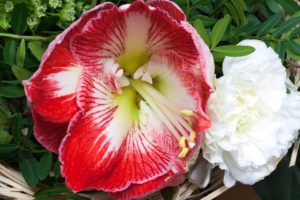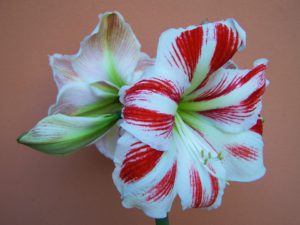Growing Amaryllis both Out and Indoors

The amaryllis plant can brighten up both your garden area and the interior plantscape, the flower of amaryllis is shaped like a bell and blooms in an array of colors. These garden beauties are native to the tropical and sub-tropical regions of the Caribbean and South America. There is believed to be 75 genre and 1600 species in the Amaryllidaceae family.
Amaryllis is popular for being used in flower arrangements apart from the landscapes and gardens so let’s take a closer look at the growth and care of amaryllis.
The planting location
Install amaryllis in an area that gets full to partial sunlight.
The soil type
The best soil type for amaryllis is a soil that is loamy, a soil that is rich in organic will provide drainage as well as retain the right amount of moisture.
Watering Methods
Avoid soaking the soil when watering your amaryllis because these garden beauties don’t like to sit in water which can lead to rot. Avoid wetting the part of the bulb that is above the ground.
Fertilizing Methods
Blossom booster, 5-10-10, or other fertilizers that are labeled for amaryllis is a good choice. Before applying fertilizers read and follow the manufacture’s direction for best results.
Garden insect pests of amaryllis
Keep an eye out for these listed pests and treat them when spotted.

- Spider Mites
- Thrips
- Aphids
- Caterpillars
Spiders Mites
Spider mites are so tiny that they can hardly be seen, their color can either be yellow, green, red, or brown these garden insect pests causes damage by sucking the plant’s sap of fluids. Signs of these mites are spider webbing, the leaves become discolored with brown flecks also. The leaves will also fall from plants that are infested, the use of insecticidal soap or horticultural oil will bring them under control. Before applying insecticides read and follow the manufacture’s direction.
Thrips
Thrips are tiny insects that can be either red, black, yellow, or dark brown. Thrips can cause serious damage because they have been known to carry viruses along with extracting the plant’s fluids causing leaf drop and failure with flower bloom. To control thrips prune or remove infected plant parts including the flowers. The use of neem oil or insecticidal soap will also eliminate them.
Aphids
Aphids are pear-shaped and can either be black, red, yellow, green, or brown. Aphids are among the sucking insect group and will cause flowers to drop. These garden insect pests also produce a sticky substance known as honeydew. This honeydew is their excrement that causes sooty mold to form. Applying soapy water or insecticidal soap will bring aphid infestation under control.
Caterpillars
Caterpillars are chewing insects that cause damage by eating plant leaves destroying their beauty. Handing picking and dumping them in a bucket of soapy water will bring them under control.
Diseases of amaryllis
Listed diseases of amaryllis
- Leaf Diseases
- Red Blotch
- Molds and Mildews
- Mosiac Virus
- Bulb Diseases
Leaf Diseases
This disease which is caused by a fungus shows up as light brown spots surrounded by a yellow or dark brown ring. Leaf diseases will also weaken plants. Treating this disease with a copper base fungicide has proven to give good results.
Red Blotch
This fungus is encouraged by cool damp conditions and causes bright red patches to appear on plant parts, as this disease is allowed to persist the patches enlargens and becomes moist. Because of difficulty in controlling red blotch the amaryllis is drugged up and destroy.
But what is recommended is to soak the bulb in water and 1 percent hydrogen peroxide for about one hour. If the bulb is growing actively replant and treat with a systemic copper-based fungicide. If the bulb is dormant dry and store, then once treatment is completed.
Molds and Mildews
This disease is caused by poor air circulation and environmental conditions, signs include leaves with lesions that are brown which also affect the flower bloom. Gray areas that are moldy will also be seen. The leaves may also develop sooty spots that are black, bring this disease under control by providing proper air-circulation, removing infected plant parts, and reducing moisture.
Mosiac Virus
Mosiac virus shows up as streaks that are light yellow, the leaves which are infected may die. Moist lesions may form alongside the leaves and the flower stalks, there may also be stunting of the flowers. There is no known cure for this disease except to remove and properly dispose of your amaryllis. Aphids are the culprits that spread this disease so controlling aphids will offer help. The use of insecticidal soap or horticultural oil will eliminate aphids
Bulb Diseases
Targets and causes root problems, bulb disease is caused by bulbs that are damaged or soils that are saturated with water. Brown to blackish areas that are slimy also appear, if measures are not taken right away bulbs become soft and begin to decay.
Avoiding damage to your bulbs is so important, give the right amount of water allowing the soil to dry out before giving your amaryllis another drink. Applying a fungicide may also offer help.
Ideas where to install amaryllis
Below are just a few places to install your amaryllis.
1. Place amaryllis in a container and use it as a centerpiece on a patio table.
2. The use of amaryllis as cut flowers or in a floral arrangement will brighten up the interior.
3. Install in your garden plant bed.
4. Grow them along a garden path walkway.
5. Plant them around the trunk of a tree provided they are getting sufficient sunlight.
6. Install amaryllis along your house foundation.
Pruning Amaryllis
Once the flowers fade remove with a hand pruner when the stalk wilts remove by cutting back where the stalk sprouts from the bulb.
Container grown amaryllis
A great way to grow your amaryllis is from a container, the container that is used should be wider than the diameter of the bulb. The container should also have drain holes for water drainage. A good potting soil that is well-drained is ideal, place a small amount of potting soil inside of the container this is the first layer next place your amaryllis in the center of the container followed by adding more soil.
Allow the upper one half of the bulb to be above ground or the soil’s surface. Gently firm the soil around the bulb and give it a good drink of water. Look for an area that provides anywhere from 70-80 degrees. The soil should dry out somewhat but still retain moisture, once new growth appears, move your bulb to a location that gets lots of sunlight. Every four weeks use a water-soluble fertilizer which will give good results. In about eight weeks flowers should appear.
Growing and caring for amaryllis indoors
Growing and caring for amaryllis indoors is a great way to add colors to beautiful flower bloom. The area that is chosen should get sufficient bright light like a window. Turning the pot on a regular basis will cause the stalk to lean towards the light. When it comes to water and pruning follow the above direction as growing amaryllis from a container.
The final word
Amaryllis flowering plants has so much to offer, these garden beauties are so amazing and will give you colors that are stunning. What I love about amaryllis is that these garden favorites can be used as cut flowers so you get the best of both worlds growing them in your garden, indoors, or using them as cut flowers in floral arrangements. These bulbs are making waves as many homeowners are taking advantage of them.
About the author
Norman loves being in the garden, both at home and for his job....
he is 'Natures Little helper' being outdoors, growing his vegetables and flowers from an early age.
Now having spent over 22 years in the profession he want to give some of his knowledge to others...
his vast array of hints and tips you will find scattered over this site will help you no end growing plants in your garden.

Hey Norman, I love amaryllis plant considering what I have read about it. It looks beautiful. Thank you for sharing this complete guide on how I can take care of them to ensure long lasting and maximum performance of the plant. These pests are stuff that really get me angry about growing plants. Hopefully, I’ll be able to put those that attack amaryllis plant under control with the knowledge gotten from this post.
The beauty of these plant types is so amazing giving that much-needed flavor. The key to helping your plants to withstand garden insect pests is keeping them healthy along with the proper pest control management. So happy to help.
Having just read your post on topiary gardens I am glad to have come across your Amaryllis plant care one as well. A big Amaryllis fan, I know that the red in these plants really has a commanding and beautiful feel, and can pair well with other plants. It’s great to know just how to care for these plants as they can be tricky. Knowing about soil types, pests and diseases are all very helpful when maintaining Amaryllis. I’m glad to have bookmarked your site as this is another very informative and helpful post. Well done!
These garden plants are so amazing and will add that much-needed flavor. Thanks so much for your kind words. Wishing you the best of success.
Amaryllis is a wonderful plant and exists in a variety of colors. But in order to obtain these beauties, we must first protect them from pests. They are very suitable both at home and abroad. You can also get wonderful bouquets of flowers. I don’t have a garden, although I like it. I don’t know, are plants more sensitive? How long does the flower last?
Good job on Amaryllis plant care instruction, Norman. Amaryllis is a beautiful plant that everyone loves growing but some people do it the wrong way. I’m glad that you pointed out some factors that is required for every Amaryllis plant grower. Getting the right location, the right soil type, and others ways are very important to the healthy growing of Amaryllis. This is very educative.
These are beautiful plants and with the right care and knowledge, you can have amaryllis that is thriving.